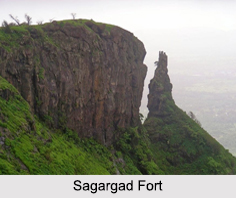 Sagargad Fort is located in Alibaug taluka of Raigad District, Maharashtra. It stands at a height of 1357 ft above sea level. This fort was built to keep an eye on the shores of Alibaug and Dharamtar creek. Sagargad Fort is a blissful trekking destination in Maharashtra that offers a panoramic view of the Arabian Sea from top.
Sagargad Fort is located in Alibaug taluka of Raigad District, Maharashtra. It stands at a height of 1357 ft above sea level. This fort was built to keep an eye on the shores of Alibaug and Dharamtar creek. Sagargad Fort is a blissful trekking destination in Maharashtra that offers a panoramic view of the Arabian Sea from top.
History of Sagargad Fort
Sagargad Fort is said to exist since the Satavahana dynasty. Sagargad Fort was won by Shivaji Maharaj from Adil Shah in 1660 A.D. It was one of the 23 forts which were handed over to Mughals in the Treaty of Purandar. It was one of the 16 fortified posts that were given to Kanhoji Angre by Balaji Vishwanath Peshwa in 1713. Prisoners sentenced to death were said to be hurled down from the monkey point of the fort. In the mid-19th century the British took the fort and built retreat homes on it.
Structure of Sagargad Fort
Sagargad Fort has a main entrance and two bastions which are completely damaged. There is a small temple of Mahishasuramardini, a Siddheshwar temple and a water tank on the way. There is also another tank inside the fort which is famous by the name of Pandav Kund. At this place, 9 tombs of Satis can be found by the travellers and is called "Sati Plateau". There is Dodhane Waterfall on the way to the fort.
Visiting Information of Sagargad Fort
Khandale village is situated on the Mumbai-Alibaug road. While travelling to Alibaug, one can reach Khandale village after crossing Karla pass. The village is about 4 miles from Alibaug. The path to the fort starts from Khandale village on Alibaug-Pen Road. A gentle walk of 2 hours from the village Khandale can reach one up to the fort.
This article is a stub. You can enrich by adding more information to it. Send your Write Up to content@indianetzone.com.



















